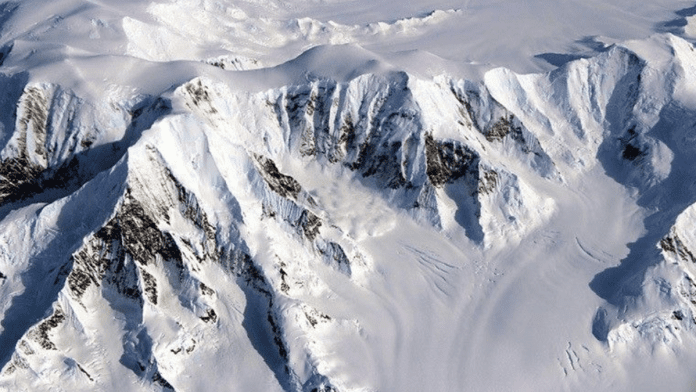🕒 Last updated on July 29, 2025
For over 500 million years, something extraordinary has been hidden beneath Antarctica’s thick, icy surface. Now, scientists are more convinced than ever: another ancient mountain range lies buried far below the snow and ice.
A Lost World Hidden Beneath the Ice
This hidden range, believed to be older than the famous Transantarctic Mountains, could be one of the oldest surviving mountain systems on Earth. It has never been seen directly. But using special tools and clever science, researchers have begun to trace its ghostly outline.
Antarctica is covered by an ice sheet that’s over 2 kilometers thick on average. That is higher than the highest buildings in the world piled on top of one another. Underneath that ice, there’s an entire hidden world—a world of valleys, hills, and now, what appears to be a second mountain range that scientists didn’t fully understand until recently.
Unlike the Transantarctic Mountains, which stretch across the continent and are partly visible, this older mountain range in East Antarctica has remained invisible to the human eye. But that hasn’t stopped scientists from finding clues about its existence.
Clues Hidden in Gravity and Magnetism
So, how can one locate mountains that are invisible? The instruments used by scientists measure intangibles like gravity and magnetism. These special machines help detect changes in the Earth’s surface.
🧊🐧 Antarctica’s Crown Crumbles: Emperor Penguins Are Dying Before They Hatch
As they scan different parts of Antarctica, scientists have found strange patterns in gravity and magnetic signals. These signals don’t match any known geological features. Instead, they hint at something very large and very old—a possible mountain range that has been completely covered by ice for hundreds of millions of years.
These readings suggest that there are giant rock structures hidden deep under the East Antarctic Ice Sheet. They are arranged in a way that is very similar to how mountain ranges form. Scientists believe that the mountains may have formed during the early Paleozoic Era, a time long before dinosaurs, when the Earth looked very different.
The data suggests that this hidden range could be over 500 million years old. That’s even older than the Transantarctic Mountains, which are believed to have formed around 300 million years ago. If true, this discovery would change what we know about how the continents moved and how the Earth’s surface evolved.
Ancient Mountains with a Global Role
These ancient mountains are more than just a curiosity. They likely played a huge role in shaping Earth’s past climate. When mountains rise, they change how air moves around the planet. This can affect where it rains or snows and how cold or warm regions become.
🌊 Freshwater Vanishing at Alarming Speed — Four Mega-Regions Face Collapse
Hundreds of millions of years ago, these rising mountain peaks may have helped cool the planet by directing winds and spreading ice. Some scientists believe this ancient uplift helped start a massive glaciation period—a time when ice covered large parts of the Earth.
Even today, the mountains under Antarctica affect how the ice moves. They act like natural walls, pushing ice to flow in certain directions. This is important because it helps determine how quickly glaciers melt and how sea levels change.
📢 Google’s ad empire under scrutiny: Did AI miss the mark on illegal gambling?
Strangely, scientists have also picked up unusual radio wave patterns from the same regions where this mountain range might exist. These signals hint at even more mysteries under the ice, suggesting a connection between Earth’s rocky layers and electromagnetic activity.
The ice over these mountains keeps them safe from erosion. While most mountains are worn down over time by wind, rain, and temperature changes, these hidden giants have been frozen in place. That makes them perfect time capsules for learning about Earth’s past.
Using tools like ice-penetrating radar and seismic surveys, scientists can now explore what lies beneath the surface without drilling into the ice. These technologies let them build detailed pictures of underground structures, helping to confirm the existence of mountains no one has ever seen.
Key Facts at a Glance
- A possible mountain range has been discovered under East Antarctica’s ice.
- It may be over 500 million years old—older than the known Transantarctic Mountains.
- Scientists detected the range through gravity and magnetic readings, not by sight.
- These mountains likely formed during the early Paleozoic Era, around the time of the supercontinent Gondwana.
- They could have influenced ancient climate patterns and even triggered glaciation events.
- The huge, protecting ice sheet of Antarctica has kept the mountains unaltered.
- This discovery adds a new chapter to the story of Earth’s geological evolution.
The globe is still in awe of Antarctica’s frozen continent. Buried under layers of ancient ice, this forgotten mountain range waited for half a billion years. Thanks to modern science, its secrets are finally starting to come to light.

